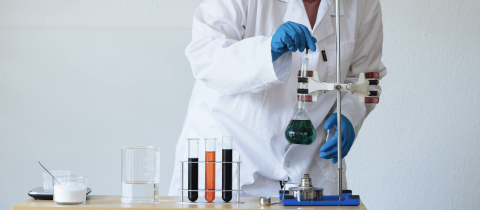Cat pee, a mouse nest, wet dog, sauerkraut, burnt match, moldy socks, rotten eggs, vanilla, menthol, and plastic bandage. An unusual list to be sure. But there is a connection. These are all terms used by expert wine tasters to describe “notes” that make up the symphony of aromas and flavours experienced when sipping a sample of the beverage that has delighted people for over 6000 years. Indeed, the conversion of grapes into wine is one of the oldest chemical processes known to humankind! And what a complex and fascinating process it is! Smash some grapes and let the juice mix with the yeast that naturally occurs on the skin and you unleash a sequence of chemical reactions that converts the sugar in the grapes into alcohol along with some 4000 other possible compounds!
Alcohol, of course, is responsible for the intoxicating effects of wine, but it is the blend of the numerous other products of fermentation that distinguishes one wine from another. With so many compounds potentially playing a role in aroma and taste, it is no surprise that no two wines taste the same. Flavours are so complex that even “aerating” a glass of wine for a short period of time will change its “bouquet” as some components react with oxygen in the air.
The type of grape, the strain of yeast, weather and soil conditions, the presence of bacteria, the nature of the barrels used, and length of aging all go towards determining a wine’s flavour and fragrance. Some compounds in the mix are more dominant than others. For example, methoxypyrazine is one of the key contributors to the aroma of Cabernet Sauvignon. It is described as “bell pepper” when it is at just the right concentration, but as an “old library book” when not. Amounts present are determined by weather conditions and soil fertility, explaining why the wine produced in different years can taste quite different, at least to the educated palate. Trained noses can even distinguish subtle differences between oniony dimethyl disulphide and asparagus-like dimethyl sulphide.
Length of aging is also critical, as odourless glycosides slowly break down to release various polyphenols that affect the scent, colour, taste and astringency of the beverage. And should an undesired strain of yeast, such as Brettanomyces, contaminate the wine, the 4-ethylphenol produced will lead to an aroma that has been described as “wet horse blanket” or “cow manure”. On the other hand, if malolactic bacteria contaminate the wine, the result can be desirable. These bacteria add a fruity aroma and nutty flavour while converting the sharply acidic malic acid to the creamier lactic acid.
Clearly, when it comes to fermentation, there is a lot that can go right and a lot that can go wrong. Wouldn’t it be interesting if a quality wine could be produced without concern for all the variables inherent in the age-old winemaking techniques? Well, that may not be outside the scope of modern chemistry! Using chromatographic separation techniques, and mass spectral identification methods, it is possible to dissect the complex flavour of wine and pinpoint the specific compounds and their concentrations that are responsible for the aroma and taste.
This is a formidable task, but not quite as challenging as it appears since most of the thousands of compounds present do not contribute significantly to the taste of the wine. For a particular variety, it may be as few as thirty-five components that determine the flavour and given these compounds can be produced in the lab or can be extracted from natural sources, creating an artificial wine that will always have the same taste. Purported health benefits are a different issue altogether, since compounds such as resveratrol, claimed by some to be responsible for the “French Paradox,” are tasteless and are not included.
The Ava Winery in California has already come up with an experimental synthetic wine that imitates the taste of a sparkling Italian white, and a Dom Perignon mimic is in the works. The idea is to mix water with key flavour molecules, drawn from a variety of esters, polyphenols, flavanoids, acids, sugars and tannins to produce an economical beverage that may taste like, but cannot legally be called wine.
So far, tasters haven’t been too kind in their evaluation, one likening the smell to “one of those inflatable sharks you take to the pool.” Others complained of missing “legs,” those streaks running down the side of the glass, and an aftertaste of “essence of plastic.” The winery retorts that this is a work in progress, but think this is one of those rare cases where nature really does know best and even chemistry might not be able to reproduce the delights of a Beaujolais Nouveau.







